
The list of great windsurfing spots in Spain. Weather features and best time to travel
Spain is undoubtedly one of the best countries in the world to practice windsurfing, and it is certainly the best in Europe. Here, the wind blows almost all year round and it is a very strong wind. What else do you need to do this kind of sport?
In this post, we have compiled all the best windsurfing spots in Spain, including the Mediterranean Sea coast and the Bay of Biscay in the north of the country, where you can practice your favorite sport or try it for the first time. Each text includes a brief description, the main characteristics of the local weather in the four seasons, and the best time to go.
Follow the link at the end of each spot to find the most accurate wind and wave forecast for it and other weather parameters for the next 10 days. Even more detailed and useful weather information is available on the spot pages.
Tarifa
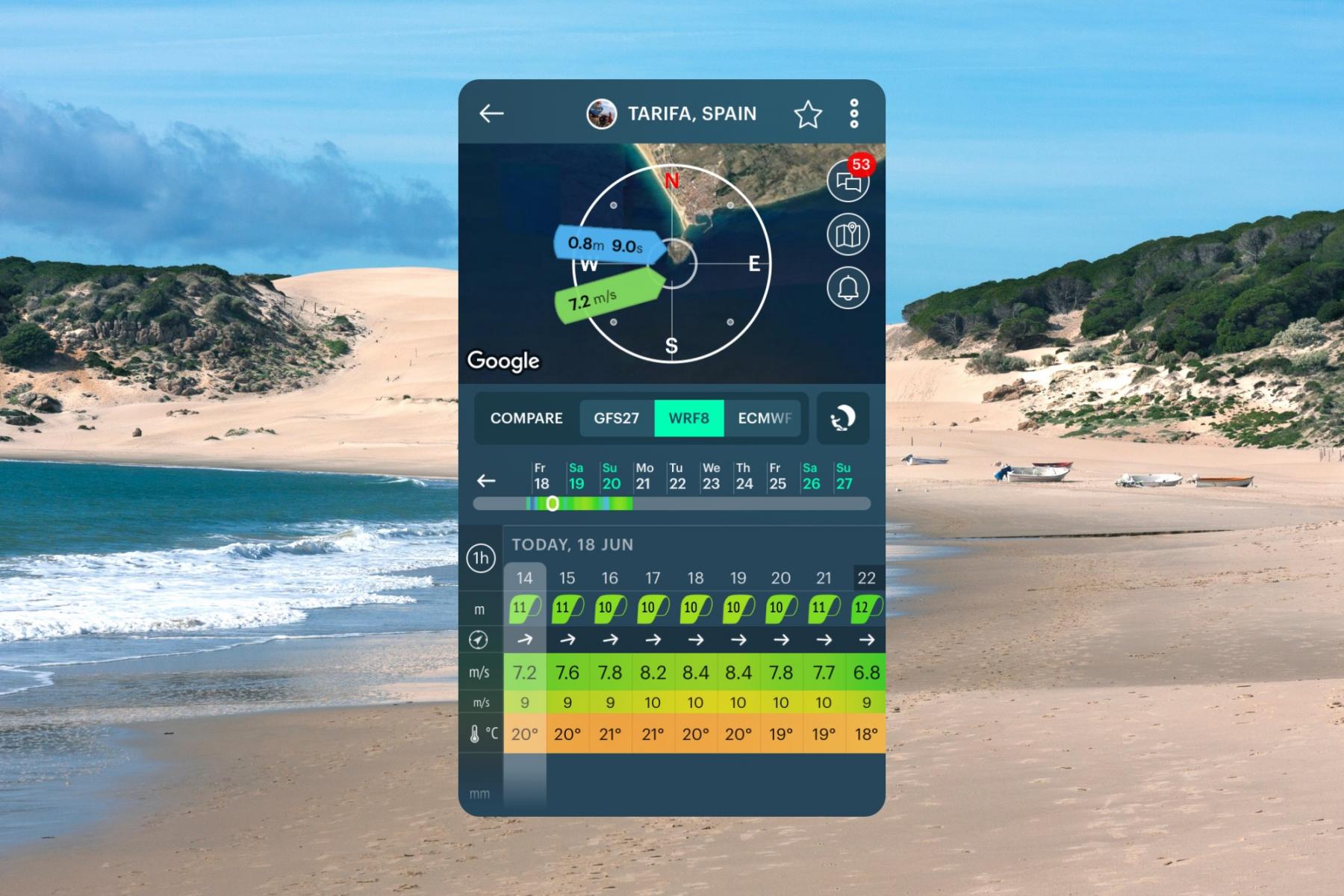
Weather forecast for Tarifa for kitesurfing, windsurfing and surfing in Spain in the Windy.app for iOS
An overview
Tarifa is known as the wind capital of Europe because of its ideal location facing the Strait of Gibraltar, a narrow area of sea between North Africa and Southern Europe where the meeting of the Mediterranean and the Atlantic and the resulting difference in air pressure creates a strong, almost constant westerly wind.
It has approximately 300 days of wind per year. That is why it has become an ideal scenario for windsurfers and kitesurfers in the world that can reach up to 80 km/h. There are two predominant winds in Tarifa: the Levante is the warm and strong easterly wind that blows offshore (from land to sea) and the Poniente is the cooler and lighter westerly wind from the Atlantic that blows onshore (from sea to land).
The views in Tarifa are privileged and it is a good place for bird watching, given its proximity to Africa, it is possible to do activities such as hiking or biking during any period of the year, being this always a complementary option to the main reason that brings travelers to Tarifa, the wind.
The main weather features
The weather in Tarifa is characterized by mild and regular temperature conditions throughout the year, it is a Mediterranean climate: temperate with oceanic influence. Rainfall can be irregular and torrential, being the period between March and November the rainiest, while between June and August there is minimal chance of rain.
- Winter. Despite being the rainiest time of the year, rainfall is not continuous, so it is possible to have rainy days followed by sunny days.
- Spring. Spring is the phase of highest wind. It is also a good period to take kitesurfing or windsurfing lessons since it is not high season, so it is perfect for beginners.
- Summer. In August the water temperature reaches the warmest of the year, it is then the most acclaimed time for kitesurfers and windsurfers but you can also practice sports such as flyboarding and paddle surfing.
- Autumn. Autumn in Tarifa, as in winter, is the season with the lowest concentration of travelers, a good choice for those who prefer to have beaches and wind only for themselves.
Best time to travel
The best months for kitesurfing in Tarifa are from May to November. The time of highest rainfall is during the winter so it is not the most ideal for water and wind sports but it is the perfect time for surfing since it reaches the maximum swell.
To choose when to visit Tarifa the spring-summer seasons are the most crowded and ideal for outdoor activities due to the perfect weather conditions.
The end of summer to the beginning of autumn is especially recommended, given the low rainfall and average temperatures of 20 °C. Given its climatic conditions, it is a place where the wind is present practically all year round.
Get the Tarifa weather forecast
Valencia
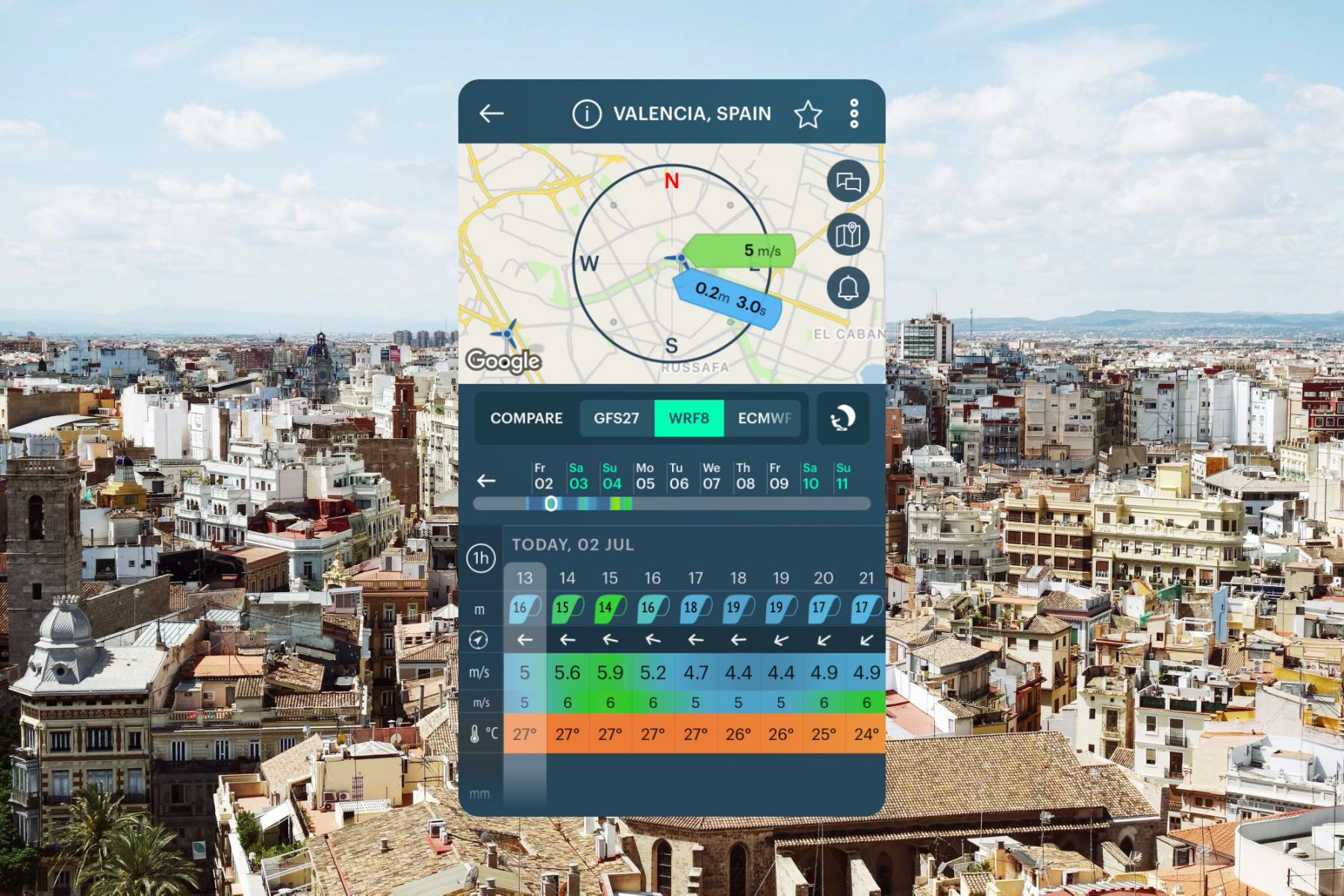
Weather forecast for Valencia for kitesurfing, windsurfing and surfing in Spain in the Windy.app for iOS
An overview
Valencia is the capital of its namesake province, located on the southeastern coast of Spain, at the junction between the Turia River and the Mediterranean Sea. Known for its wide beaches and warm waters, its famous for thermal winds, which have made it an established spot for water sports.
It has easy access to multiple beaches and one of the most avant-garde marinas in Europe. In addition to schools to get started in these practices.
The main weather features
The weather in Valencia is characterized by hot, humid and clear summers, winters are windy and partly cloudy. It has a low level of rainfall per year, about 46 days of rain in 365 days (420 mm). It has thermal columns and winds throughout the year. The spot offers ideal conditions for the practice of wind sports.
- Winter. Although this is the season with the highest wind speed, Valencia is still a great alternative for kitesurfing beginners because of its wide and therefore safe beaches for beginners.
- Spring. The weather in Valencia during this period brings with it the north wind, also known as Tramontana, makes the city of Valencia famous for kitesurfers and windsurfers, given the high swell it produces and therefore squalls. The tide level data can be useful for any water sport.
- Summer. The constant thermal winds Garbí and Llebeig result in sea with little swell, so it is not an ideal time for experts but for beginners in the practice of kitesurfing.
- Autumn. With the autumn comes the squalls and the westerly and terrestrial winds, in addition to beaches with little concurrence, begins the ideal period for the most experienced kitesurfers.
Best time to travel
The best time to visit Valencia for kitesurfers and windsurfers will depend on what you're looking for, each time of year is ideal for different objectives. What is certain is that the different beaches, with different types of wind and weather conditions make Valencia a destination to visit at any time.
Summer would be the least recommended season, since there are restrictions on most beaches, especially for kitesurfers.
Barcelona
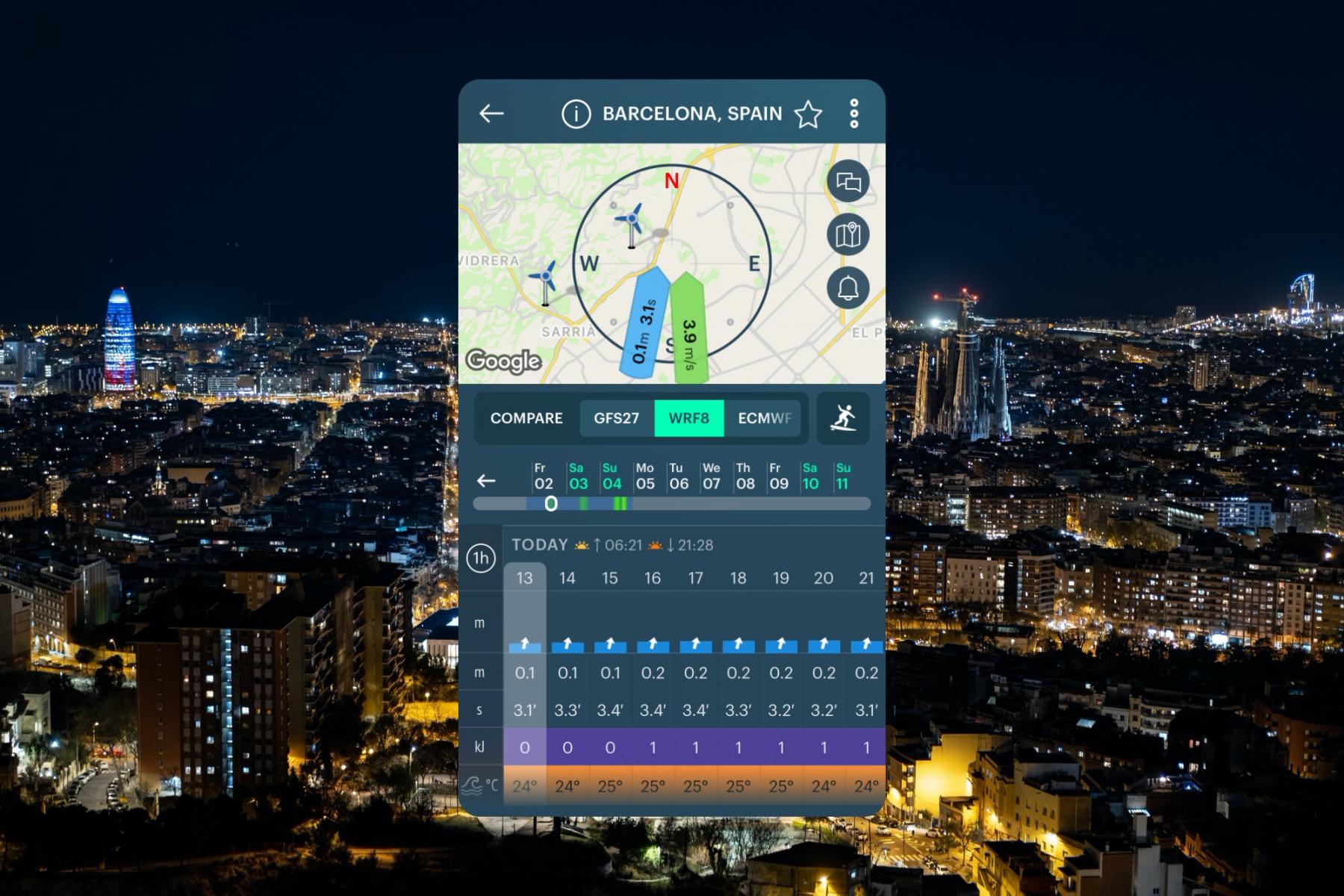
Weather forecast for Barcelona for kitesurfing, windsurfing and surfing in Spain in the Windy.app for iOS
An overview
Barcelona is the capital of Catalonia, located on the northeastern Mediterranean coast of Spain. It is recognized as a cultural and leisure destination but over the years it has become increasingly popular as a surfing destination.
Being a coastal city, it has easily accessible beaches and more than 100 km of sandy strips. Eight beaches are suitable for surfing, all with sandy bottoms swells from the northeast, east, and southeast. Wave sizes start at 0.5 m/s and reach up to 3 m/s. This makes it an ideal destination for beginners.
Among the most recommended beaches are Barceloneta, La Caleta, Montgat, and Badalona. The alternative in terms of water sports and taking into account that there is no absolute consistency of waves would be paddle surfing and during the spring-summer period windsurfing.
The main weather features
The weather in Barcelona is classified as warm temperate, typical Mediterranean. It is characterized by mild temperature conditions with no major seasonality. There are about 56 days of rain per year, mostly during the autumn-winter period, with July being the driest month. It is located 12 meters above sea level and has a relatively constant humidity always above 70%. The month with the strongest wind and high speed is March (9.8 km / h) but with gusts that can reach up to (26 km / h).
- Winter. The weather in Barcelona during March has the highest wind speed, reaching almost 12 m / h, and is, therefore, the time of year that offers more thrills for the experienced, but still ideal for even intermediate levels.
- Spring. The sea is flat and there are no breaks on the coast. It is an ideal time for windsurfers of any level of experience.
- Summer. The strong thermal wind, characteristic of this season, allows having a consistent windsurfing season, with several days of Garbí wind assured.
- Autumn. Predominantly northwest-east winds, the swell is strong on the shore making it difficult just to enter or returning with a roll to the windsurfers.
Best time to travel
The best time to visit Barcelona for surfers is between September and March, this is the time when the best waves are found. From spring and during the summer it is almost impossible to find days with the good tide, in addition to the number of tourists visiting the city and therefore the beaches that make it almost impossible to enter the water.
Although the consistency of waves is not like in other areas of Spain and therefore it is not possible to practice at any time, we are talking about an average of 130 days a year, which makes it an interesting destination for surfers.
It is important to check the forecasts carefully so as not to miss a single day. Learn how to read the surf forecasts and make the most of the weather.
Barcelona weather forecast, more spot info and advice
Badalona
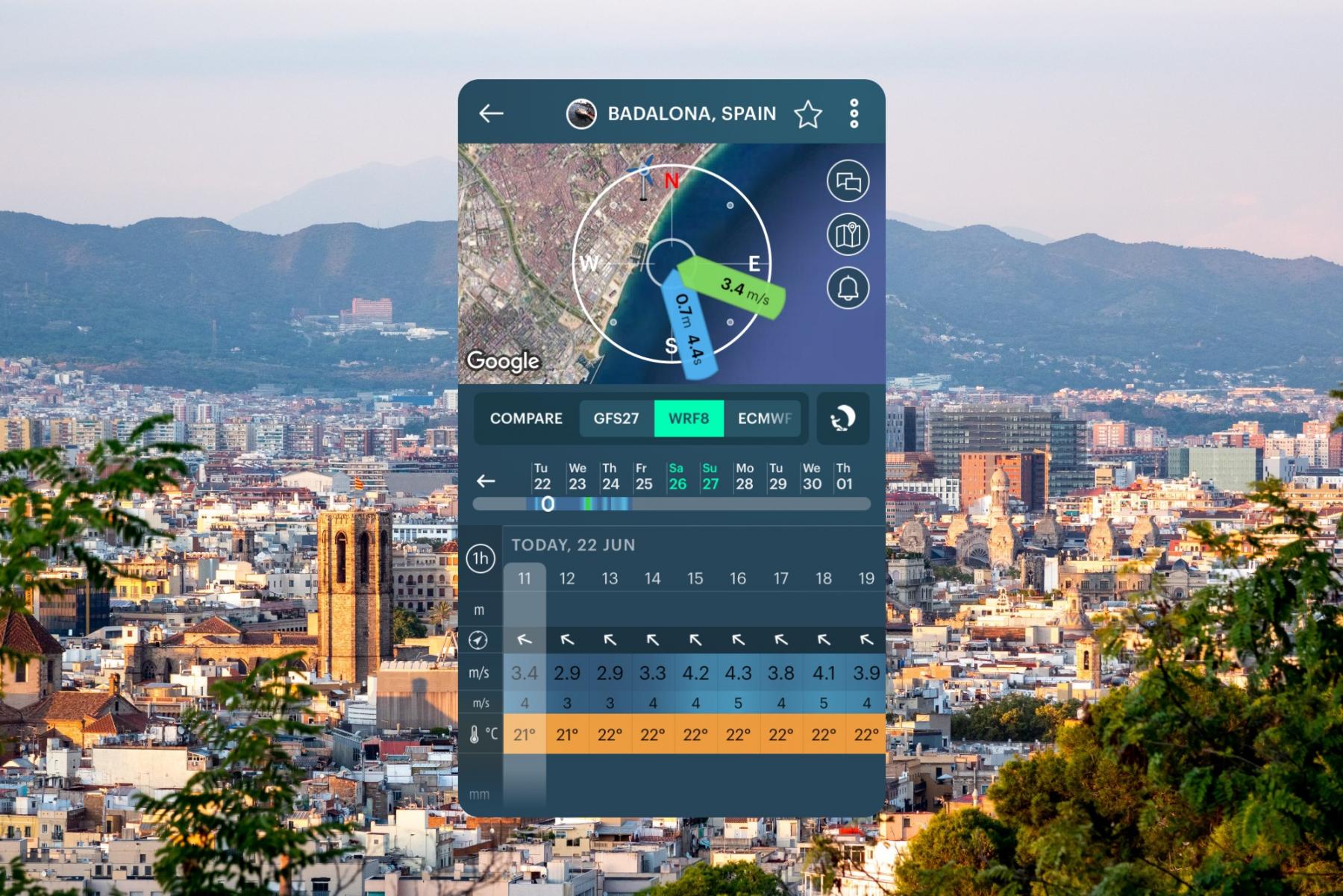
Weather forecast for Badalona for kitesurfing, windsurfing and surfing in Spain in the Windy.app for iOS
An overview
Badalona is a municipality located on the coast of the Mediterranean Sea just 10 km from Barcelona and is the ideal place for windsurfing in this area. It enjoys strong and constant thermal wind, with breezes that invade from August onwards. The easterly is strong and challenging, but it is possible to sail. On the other hand, the west is almost impossible because it does not reach the shore.
It is evident that compared to other destinations in Spain it does not have characteristics 100% appropriate for wind sports, but in the area, it is one of the best that can be found.
Recommendation, check the varied offer of excursions and hiking trails Badalona has countless parks.
The main weather features
The weather in Badalona is classified as warm temperate, typical Mediterranean. It is characterized by mild temperature conditions with no major seasonality. The average annual temperature is 15.5 °C, with highs of 27 °C in August and lows of 4 °C in January. There are about 100 days of rain per year, mostly during the autumn-winter period, with July being the driest month. It is located 13 meters above sea level and has a relatively constant humidity always above 65%. The month with the strongest and highest wind speed is March (11.8 km/h) and the calmest and lowest wind speed is August (9.4 km/h).
- Winter. Given the low water temperature, windsurfers are recommended to sail with long-sleeved neoprene.
- Spring. The sea is flat and there are no breaks on the coast. It is an ideal time for windsurfers of any level of experience.
- Summer. The strong thermal wind, characteristic of this season, allows having a consistent windsurfing season, with several days of Garbí wind assured.
- Autumn. Predominantly northwest-east winds, the swell is strong on the shore making it difficult just to enter or returning with a roll to the windsurfers.
Best time to travel
The best time to visit Badalona for more experienced windsurfers will be autumn-winter, marking March and October as key months. The waves will be more demanding and just getting into the water could be difficult.
The spring-summer seasons are ideal for any level, even for beginners, finding the famous Garbí winds, calm and smooth, allowing you to enjoy much more relaxed windsurfing sessions.
It is important to select the right board according to the season, here is detailed information on how to choose the size of your board.
The more varied the equipment the more you can enjoy, in general, the experts in the area recommend large sails to ensure a good windsurfing session.
Badalona weather forecast, more spot info and advice
Cartagena
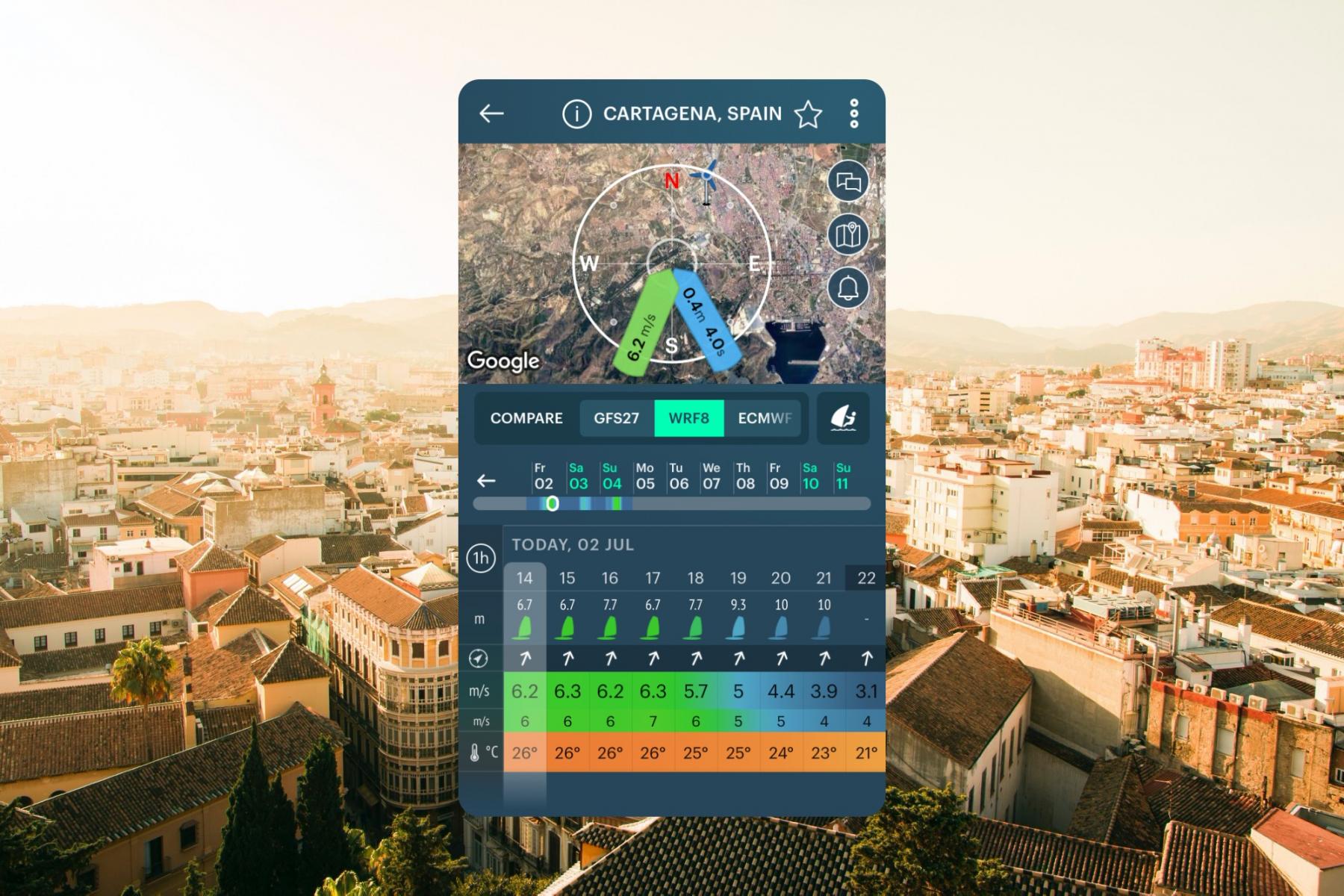
Weather forecast for Cartagena for kitesurfing, windsurfing and surfing in Spain in the Windy.app for iOS
An overview
Cartagena is a port city located on a wide bay, capital of the autonomous community of Murcia, and situated on the Mediterranean coast, in the area known as Costa Cálida, in Spain. It is located on five small hills and therefore offers hiking options in addition to the maritime offer.
The main weather features
The weather in Cartagena is the Mediterranean, with mild winters and little rain and hot and sunny summers. It is located 19 meters above sea level. It has only some rainfall during the year, about 31 days of rain per year and a total of 272 mm. To become an expert in meteorology follow the textbook.
- Winter. The most frequent winds during this season are from the east and northeast so waves can reach up to 2 m.
- Spring. The weather in Cartagena during this period brings winds from the southwest.
- Summer. Thermal winds from the southeast result in a sea with little swell.
- Autumn. The most recommended beach during this period is Playa Paraiso with northeast and northeast winds, suitable for an intermediate level of experience.
Best time to travel
The best time to visit Cartagena for surfers without a doubt is autumn-winter where they will find the most demanding waves. While between spring and summer windsurfing and kitesurfing enter the scene. However, the restrictions of the summer make it not a favorite period or at least a phase in which you should plan in a more detailed way the activity to be performed.
Cambrils
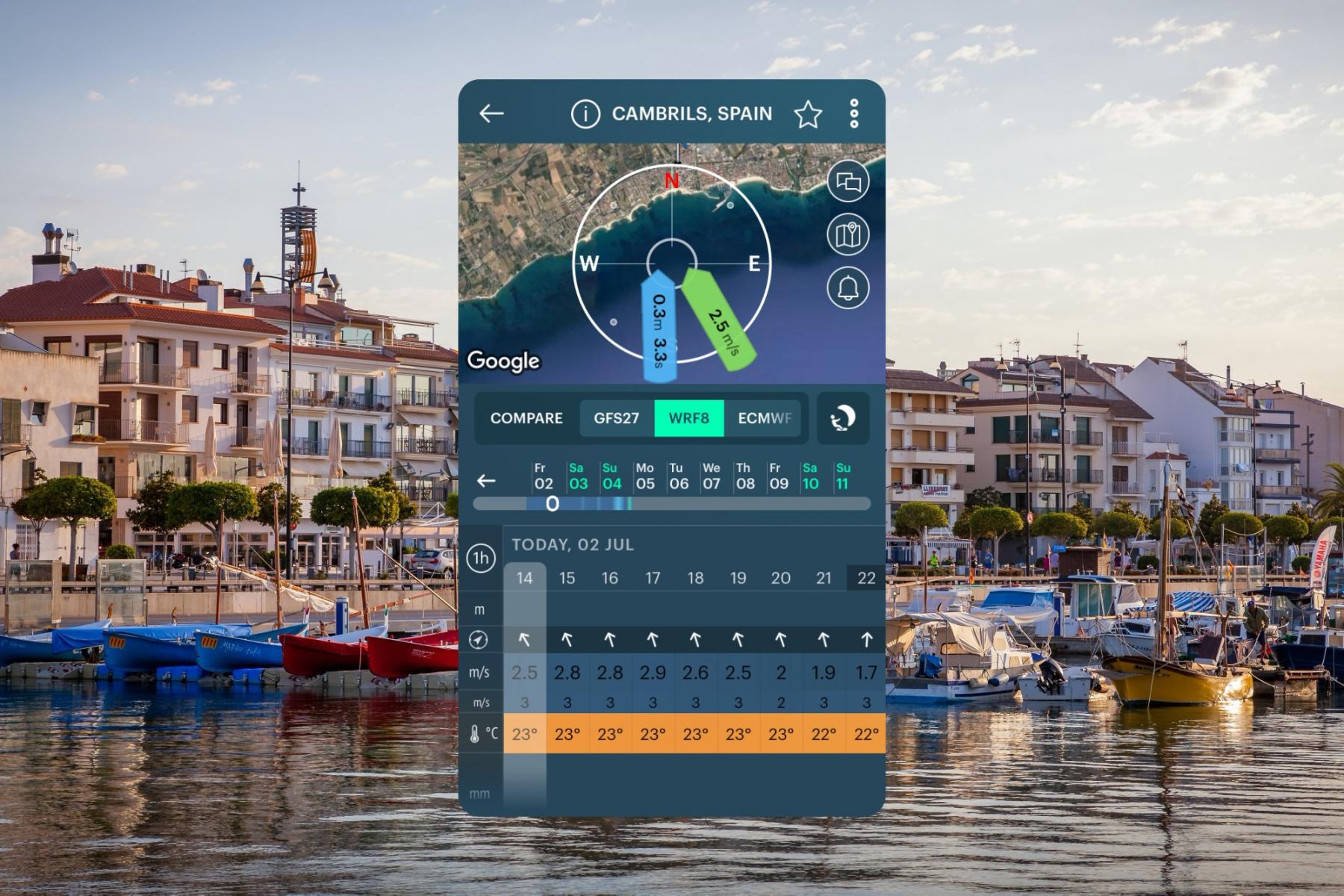
Weather forecast for Cambrils for kitesurfing, windsurfing and surfing in Spain in the Windy.app for iOS
An overview
Cambrils is a municipality located in the northeast of Spain, in the south of Catalonia. It has 9 km of sandy beach on the Mediterranean. Although compared to other destinations in Spain it does not have characteristics 100% suitable for wind sports, it is an ideal place to start windsurfing and therefore has an important number of schools available throughout the year.
The main weather features
The weather in Cambrils is classified as warm and temperate, Mediterranean. In particular, rainfall in winter is rarer than what normally occurs in Mediterranean climates. There are about 55 days of rain per year with a total of 540 mm. It has both westerly and easterly winds.
- Winter. The average temperature is 7 degrees and it is quite rainy - not very good weather conditions for windsurfing
- Spring. The Garbí wind predominates, blowing across the shore from the right, and is reinforced by the sea breeze.
- Summer. The strong thermal wind, characteristic of this season, allows having a consistent windsurfing season.
- Autumn. This is a period for experienced windsurfers from fairly large waves and strong wind.
Best time to travel
The best time to visit Cambrils for windsurfers is the spring-summer season with the best weather conditions. Autumn can also bring good sessions but only for the most experienced.
Cambrils weather forecast, more spot info and advice
Motril
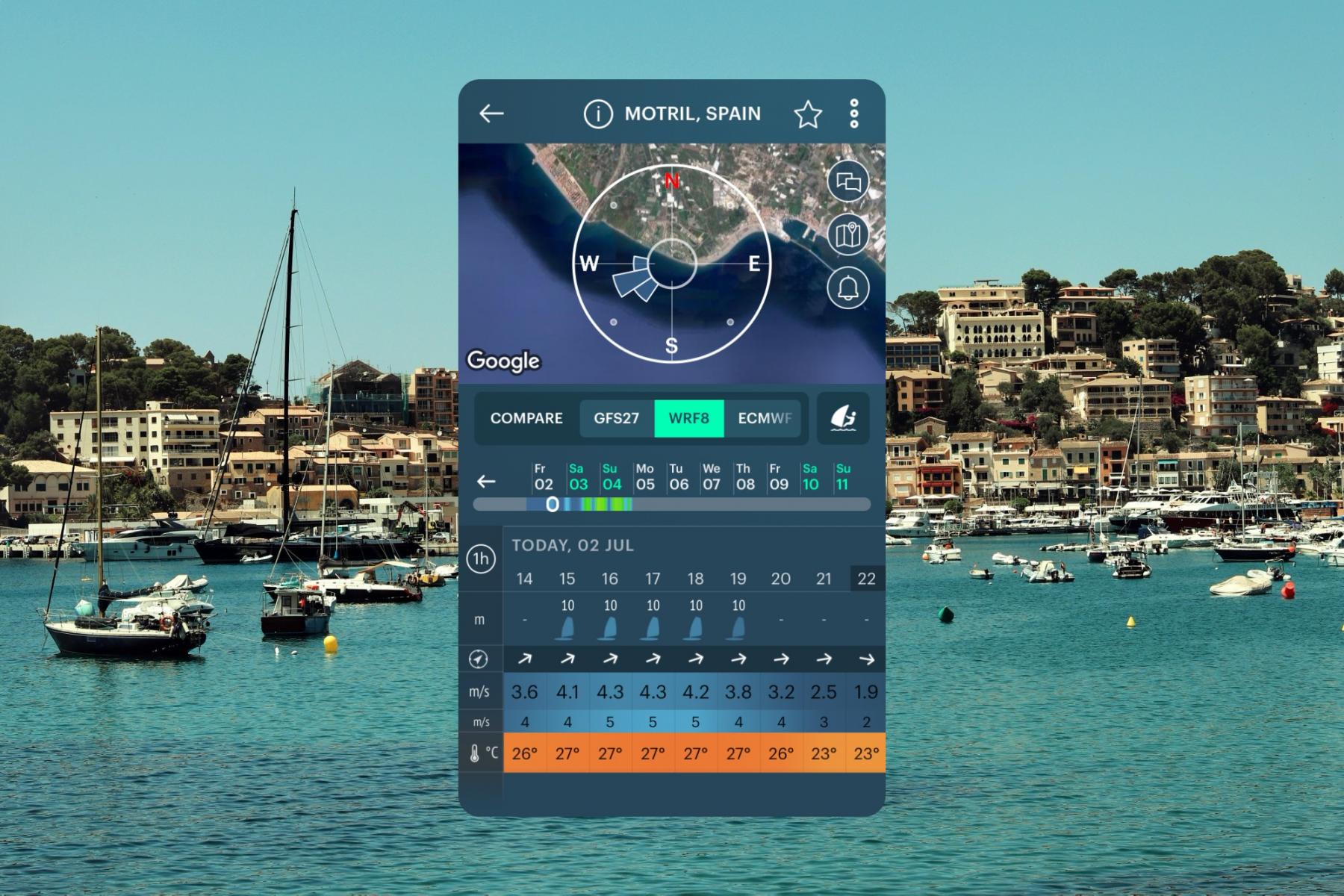
Weather forecast for Motril for for kitesurfing, windsurfing and surfing in Spain in the Windy.app for iOS
An overview
Motril is located on the shores of the Mediterranean, in the central part of the Costa Granadina, in the autonomous community of Andalusia in Spain. It has an important windsurfing tradition and many schools. It is interesting the possibility of doing wind sports not only on the coast but also in the nearby reservoirs, finding more controllable conditions and sometimes more favorable than those of the sea.
It also has ideal scenarios for both surfing and kitesurfing, with different characteristics and levels of demand.
The main weather features
The weather in Motril is the Mediterranean, with mild and relatively rainy winters and hot and sunny summers. The wind blows frequently and in the cold half of the year is accompanied by rain and showers, while in summer it blows as an afternoon breeze. The highest mountain range of the Iberian Peninsula is located near this city, generating effects in its climatology.
- Winter. The weather in Motril during the winter can be very variable, days with light and moderate winds and others with large waves of more than three meters and winds of more than 60 kilometers per hour on the coast, which is an ideal scenario for experienced surfers.
- Spring. From spring onwards, thermal winds from the southeast begin to blow with average temperatures of 23 °C, ideal for kitesurfing.
- Summer. In August the water temperature reaches the warmest of the year, it is then the most acclaimed time for kitesurfers but there are restrictions due to the high influx of people on the beaches
- Autumn. It is a time with high and powerful waves, therefore it is more suitable for right-handed kitesurfers.
Best time to travel
The best months for windsurfing and kitesurfing in Motril are from May to November. The time of highest rainfall is during the winter so it is not the most ideal time for water and wind sports but it is the perfect time for surfing since it reaches the maximum swell.
To decide the right time to visit Motril we recommend you to know how the wind rose works, it can be very useful to know the weather conditions of the area.
Zarautz
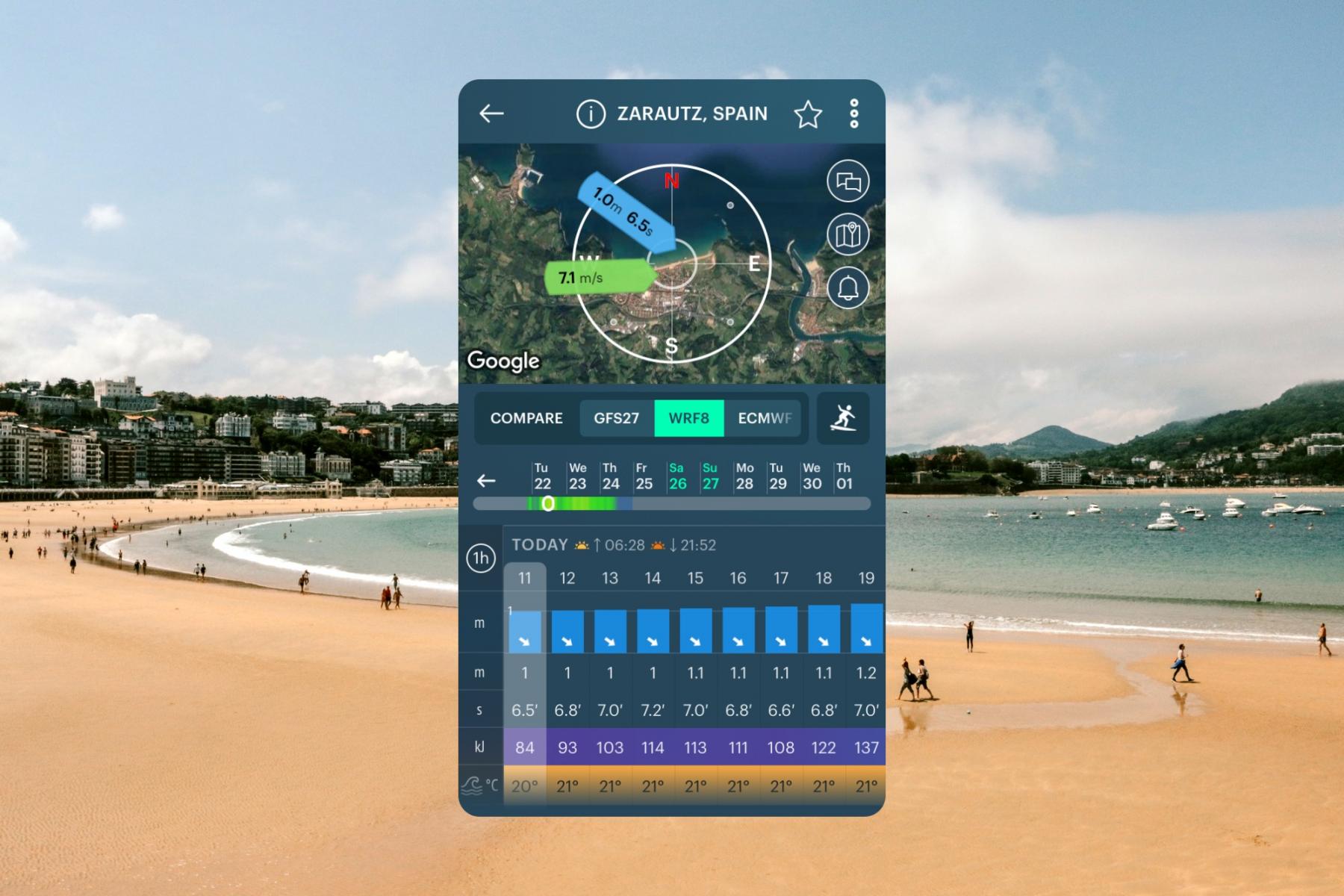
Weather forecast for Zarautz for kitesurfing, windsurfing and surfing in Spain in the Windy.app for iOS
An overview
Zarautz is the surfing capital of the Basque Country, it offers the conditions that every surfer wants to find, good wind and waves. It is an urban beach, its tide is variable most commonly medium, the bottom is sandy and it is a place suitable for surfers of any level of experience. It works best with the wind S. It has both lefts and rights maneuverable. It is an area of a high influx of surfers, especially locals in almost any season of the year. Finally, it has schools all along the beach, it is an ideal destination for beginners, here is detailed information on how to choose a surf school.
The waves depend on the weather conditions but predominantly perpendicular to the coastline, this is due to its location in the open sea. The waves are consistent and start from the west, arriving with equal power to the east.
The main weather features
The weather in Zarautz is classified as warm-temperate, subpolar oceanic with few temperature oscillations. It is characterized by being rainy, 1417 mm annual average. Winters are long, cold, wet, and windy and it is partly cloudy all year round. The temperature in Zarautz starts from 4 °C in February as a minimum of the year and 19 °C as a maximum in August. Humidity is always above 75%.
- Winter. In winter, there are good and high waves, but the temperature rarely rises above 10 degrees and it rains 50% of the time
- Spring. Swells are consistent but not very large and the beaches are completely empty.
- Summer. It is a good season for beginners due to the calm sea, the waves do not exceed one and a half meters.
- Autumn. The sea wakes up after the summer session and brings with it squalls and therefore high waves but rainfall at an average of 49 days
Best time to travel
The best time to visit Zarautz if it’s for surfing will depend on your level of experience and the style you want to practice. It is a windy city but the windiest part of the year goes from October to April with average speeds of 13 km / h the rest of the year on the other hand has an average of 11 km / h. So for beginners, the ideal period would be spring-summer while for intermediate or experts autumn-winter. It is always advisable to take a look at the current regulations for surfers, here you can see them.
Lanzarote
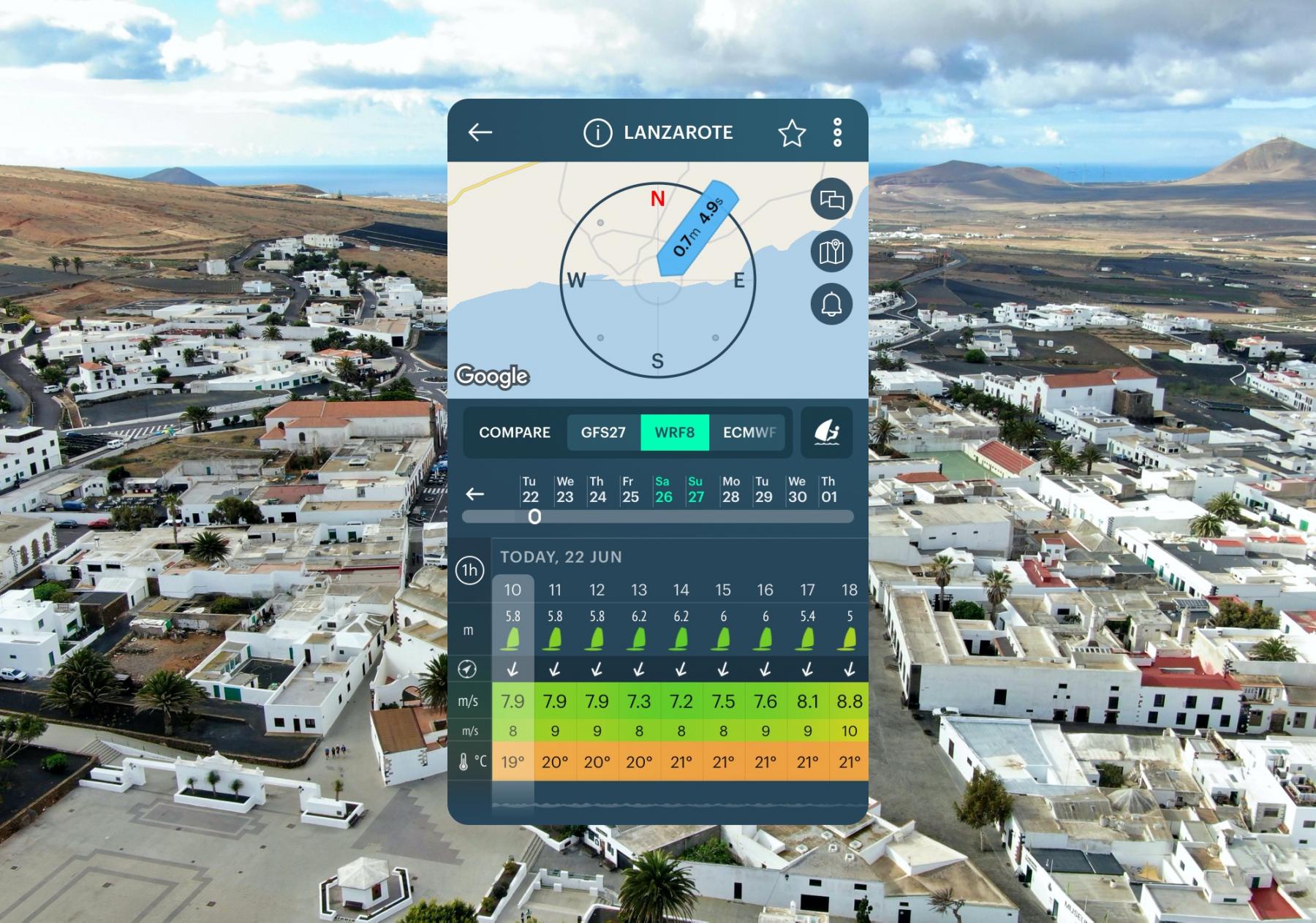
Weather forecast for Lanzarote for kitesurfing, windsurfing and surfing in Spain in the Windy.app for iOS
An overview
Lanzarote is part of the Canary Islands, off the coast of West Africa, and located in the province of Las Palmas in Spain. It is the ideal destination for kitesurfing and windsurfing lovers, with excellent wind conditions during a good period of the year.
Famara beach is a favorite for kitesurfing because it has ideal wind conditions and because it has several peaks in the deepest areas that allow kitesurfers to make pirouettes in the air and execute their movements with ease.
Windsurfers, on the other hand, have two central areas. For beginners Las Cucharas and for the more experienced Jameos del Agua, a place located in the north of the island that allows lefts especially when the trade winds are present.
The main weather features
The weather in Lanzarote is characterized by mild winters and hot and sunny summers. It is a subtropical climate with constant sunshine and low rainfall, which generally does not exceed 150 mm per year. It has wind currents such as the northeast trade winds during the summer and is also influenced by its proximity to the Sahara Desert and the land breeze, constant and strong wind that comes from the earth with great propulsion.
Temperatures range from 14 °C to 29 °C. The weather in Lanzarote is determined by two microclimates, the northern one which is much windier and more humid, and the southern one which is warmer and drier.
- Winter. It is possible to find windy days during the winter, although less strong than in the summer, to practice kitesurfing or windsurfing, but given the water temperature of 17°C on average, the use of neoprene is recommended.
- Spring. It is an ideal season for beginners that wind that blows more consistently and of higher quality than in other seasons of the year and there are few tourists.
- Summer. There are good trade winds From June to August - it is ideal for kitesurfing
- Autumn. There are too few windy days during this period, so it's worth choosing other places for skiing
Best time to travel
The best time of year to visit Lanzarote, for the purpose of kitesurfing and windsurfing, is undoubtedly summer, especially June and July when the trade winds reach their peak. However, months like April in the spring and December in the winter are still interesting options especially to avoid the high influx of bathers during the summer.
Autumn is definitely not the best time to visit Lanzarote, with almost no wind it is not the ideal season for kitesurfers or windsurfers.
Marbella
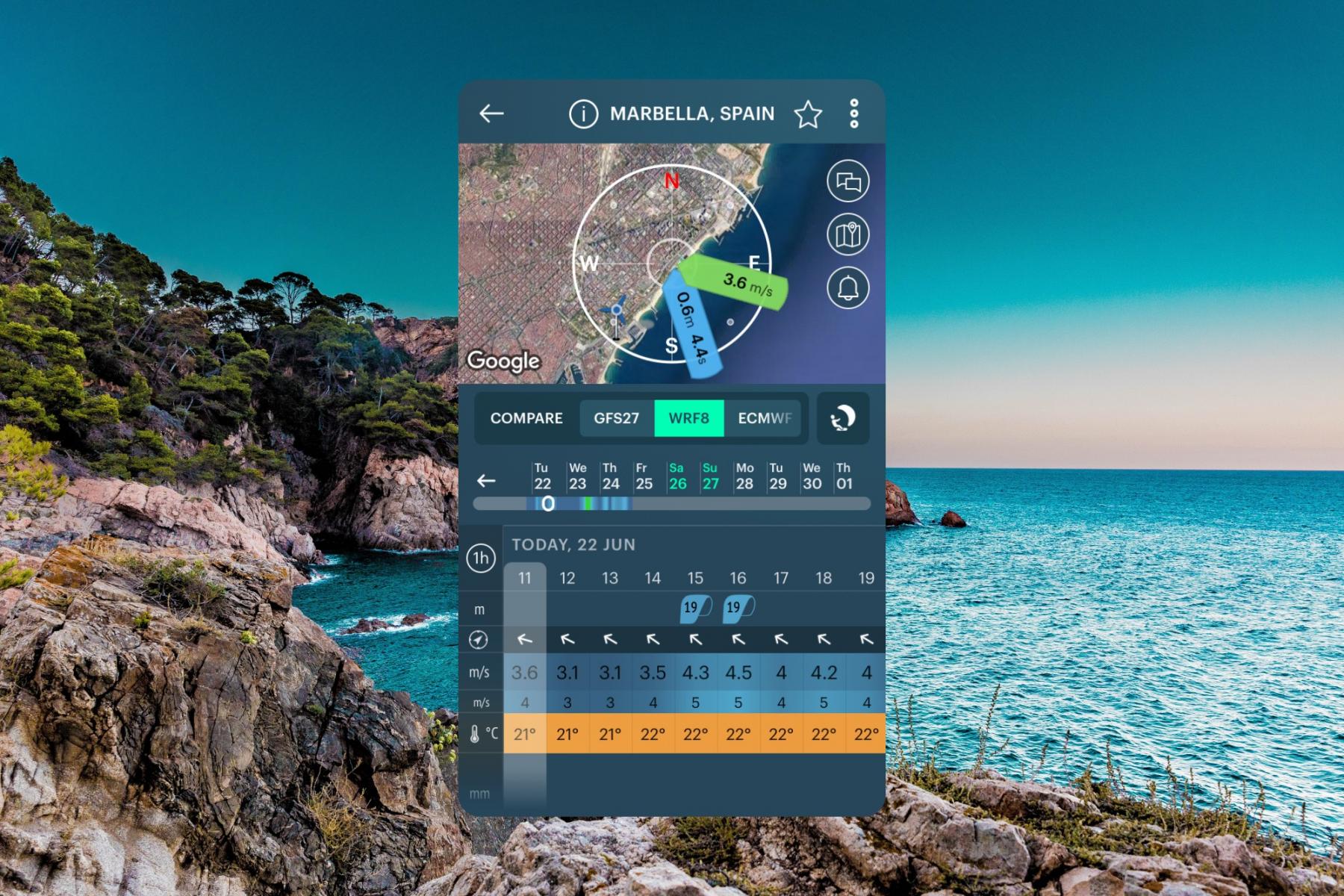
Weather forecast for Marbella for kitesurfing, windsurfing and surfing in Spain in the Windy.app for iOS
An overview
Marbella is a large and popular seaside town on the southern coast of Spain, between Gibraltar and Malaga.
Marbella is a destination known for its benevolent climate with few days of rain per year, at least 300 days of sunshine, and with certain particularities given its geographical position in which the surrounding mountains and the inlet configuration of the coast serve as a blockade of the north winds which produces a unique microclimate.
It has several beaches where surfing and kitesurfing are protagonists:
- Playa del Pinillo is one of them, there are good waves for surfers as they are not loaded with force is an ideal place for any level of experience.
- For its part, Cabopino is ideal for kitesurfers. The latter requires prevention since it is delimited with rock breakwaters, which can be dangerous for kitesurfing, especially when there is a westerly wind.
- For the most skilled in kitesurfing, Playa Rio Real is the ideal place, has pronounced rock formations so it is a place reserved for experts of the board.
- Playa Guadalmansa is characterized for being one of the beaches with the highest number of windy days per year and has the largest number of schools.
The main weather features
The weather in Marbella is characterized by mild and regular temperature conditions throughout the year, it is a Mediterranean climate, hot, humid, and arid summers and long, cool, windy, and partly cloudy winters. The temperature has a maximum of 29 °C in August and a minimum of 8 °C in January. About 668 mm of precipitation per year, mostly during the autumn-winter period, with July being the driest month. It is located 60 meters above sea level and humidity varies between 60% and 74%.
- Winter. February is the windiest month of the year, reaching up to 18 km/h so there is no congestion of travelers
- Spring. From spring onwards, thermal winds from the southeast start to blow with average temperatures of 23°C, ideal for windsurfing.
- Summer. August is the least windy month of the year with an average speed of 13 km/h but the water temperature reaches the warmest of the year
- Autumn. As in winter, the season with the lowest concentration of travelers, a good choice for those who prefer to have beaches and wind only for themselves.
Best time to travel
The best months to kitesurf in Marbella depend on your level of expertise and what your goal is. Any time of the year is suitable because it has excellent weather conditions of wind and sun. To determine the most appropriate season it is convenient to establish whether you are looking for strong or light winds, given the large number of beaches dedicated to kitesurfing in Marbella it is possible to practice all year round without major restrictions.
Cadiz
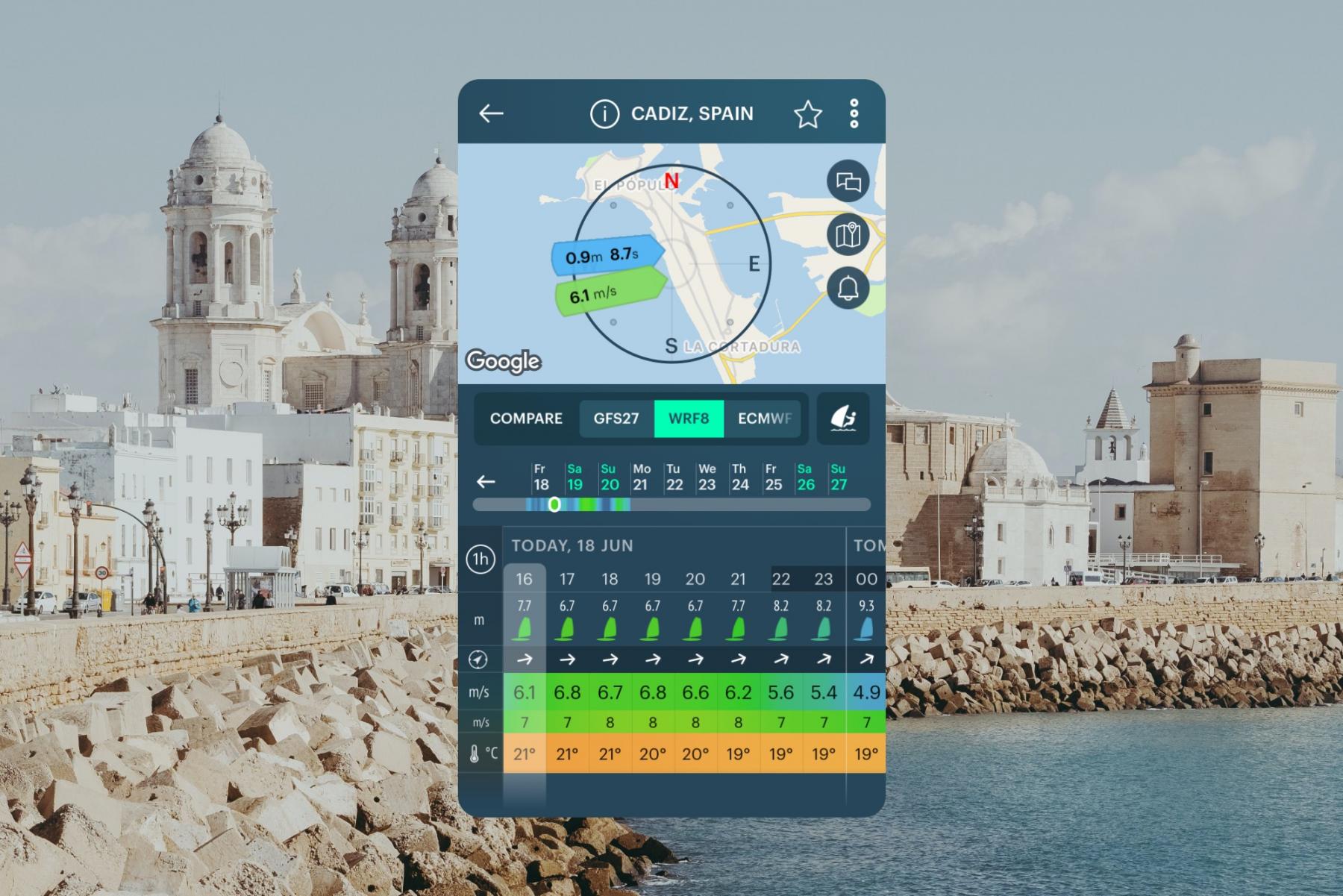
Weather forecast for Cadiz for kitesurfing, windsurfing and surfing in Spain in the Windy.app for iOS
An overview
The coast of Cadiz is ideal for all types of water sports throughout the year, which is why this area enjoys great popularity among professionals and amateurs. It offers a wide variety of complementary services such as schools, equipment rentals, and accessory stores.
The beaches of Cadiz have gentle waves, sandy bottoms and usually do not present strong currents, making it an ideal place for beginners at any time of the year. It is possible to enjoy the Atlantic with the practice of surfing, kite surfing, sailing, scuba diving, diving among the most prominent. Los Caños de Meca is famous for its crystal clear waters and white beaches.
The rest of the province offers activities such as hiking in the different natural parks or combine with the risk and adventure of canyoning, mountaineering, or paragliding.
The main weather features
The weather in Cadiz can be classified as warm Mediterranean subtropical. It is characterized by mild temperature conditions without major seasonality, dry summers, and rainy and changeable winters due to the polar front, with November being the month of highest rainfall, while July is the warmest and driest month. It has an average humidity of 72%, with little variation during the year.
- Winter. March and December are the windiest months with wind speeds of more than 30 km/h. In this period of the year, the westerly wind is the most common, hitting the Sierra causing heavy rains.
- Spring. It is the beginning of the season of easterly winds, the period in which these are strong so we recommend kites or sails of medium or small size to avoid breakage or complication in the control of the artifacts given its intensity.
- Summer. Summer in Cadiz is long and hot due to the high humidity that increases the thermal sensation but there are restrictions due to the high influx of people on the beaches, so it is not an ideal time for kitesurfing or windsurfing.
- Autumn. Given the low influx of bathers, it is an ideal season for wind and there are even fewer restrictions and therefore more options for beaches and some salty rivers.
Best time time to travel
The best time to visit Cadiz depends on the sport, the level of expertise, and the athlete’s goal. Any time of the year is suitable as it has excellent weather conditions of wind and sun.
To determine the most appropriate season it is convenient to establish whether you are looking for an easterly or westerly wind. The easterly wind is between May and October and is perfect for windsurfing and kitesurfing experts who want to perform tricks and have powerful equipment. On the other hand, the Poniente, which would be the season between November and April, is ideal for clear and clean skies, bright sunshine, and fresh but less powerful wind.
For surfers, winter is undoubtedly the best season since it is when you get the best waves.
Malaga
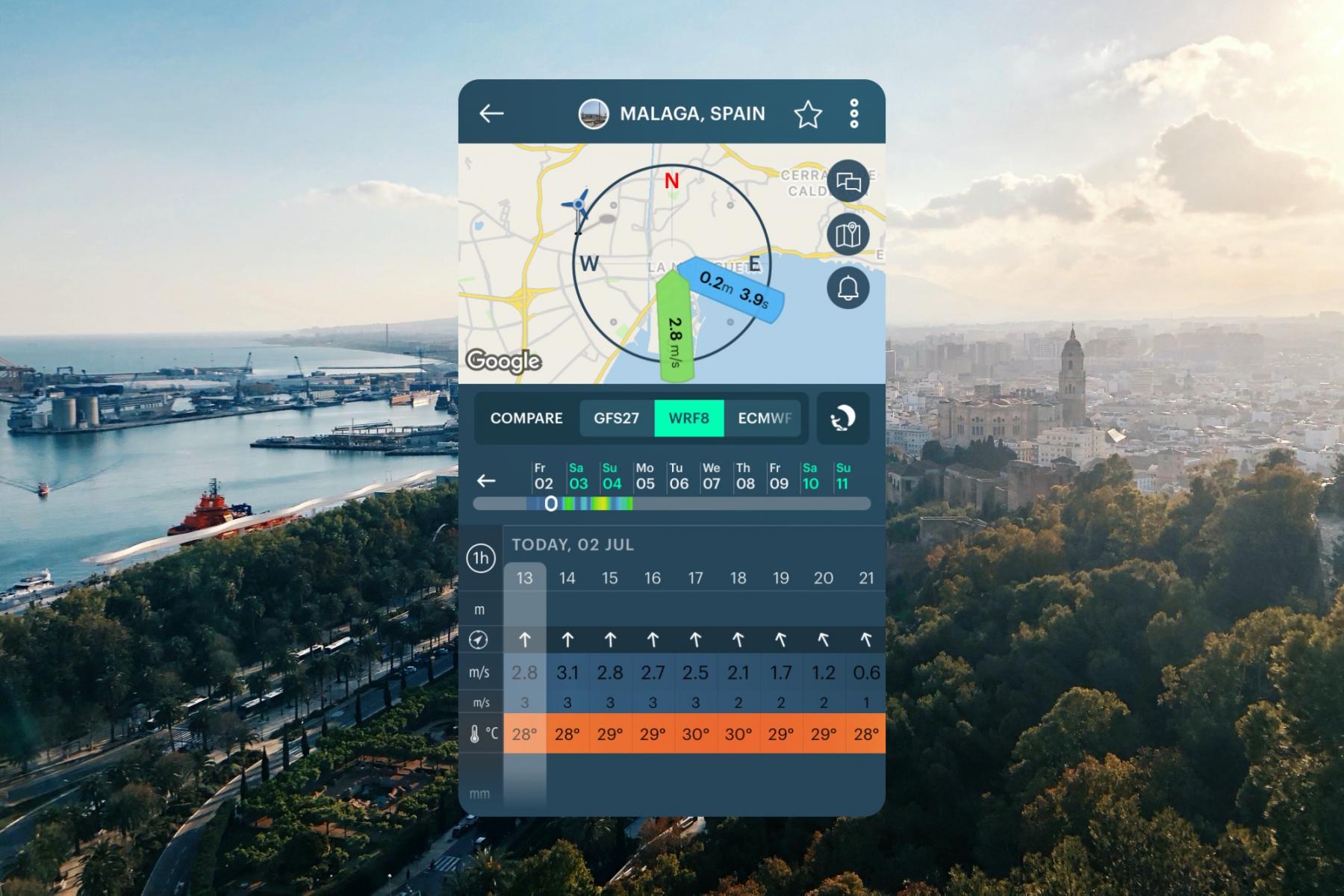
Weather forecast for Malaga for kitesurfing, windsurfing and surfing in Spain in the Windy.app for iOS
An overview
Malaga is located in the south of the Iberian Peninsula, on the Costa del Sol, the westernmost part of the Mediterranean. It is the capital of its homonymous province in Spain and has 14 km of beaches.
It is not a city of surfing tradition, because the weather in Malaga is not ideal for water sports, but it still has its audience and allows surfing in both the east and west. The waves are not of good consistency but are still suitable for surfing sessions, especially for less experienced surfers.
The three beaches recommended for surfers are Playa El Chanquete, Playa de Benajarafe, and Playa de Artola, in all of them it is possible to surf in the east and/or west.
The main weather features
The weather in Malaga is characterized by mild and regular temperature conditions throughout the year, a subtropical Mediterranean climate, hot, humid, and arid summers and is recognized as the city with the warmest winters in Spain. About 480 mm of rainfall per year, mostly during March and November, with July being the driest month. It is located 11 meters above sea level and humidity varies between 60% and 72%.
- Winter. February is the windiest month of the year, reaching up to 18 km/h so it's not good period for windsurf.
- Spring. Temperatures during this period range between 10 °C and 24 °C and on average there are 22 days of rain (58 mm) in the total season.
- Summer. The month of few winds but with good waves so it is not an ideal time for windsurfing.
- Autumn. It is the wettest period of the year with 80 mm and 20 days of precipitation in the total season.
Best time time to travel
The best time to visit Malaga for surfers although it may seem strange in the summer, although you get few waves are of better quality than in the winter. The alternative is kitesurfing which is another sport practiced in the area, it is also recommended to do it during the summer, always checking the possible restrictions that are presented on the different beaches of the city and having as an alternative Marbella, located in the province of Malaga with multiple beaches for the practice of kitesurfing.
Malaga weather forecast, more spot info and advice
Almeria
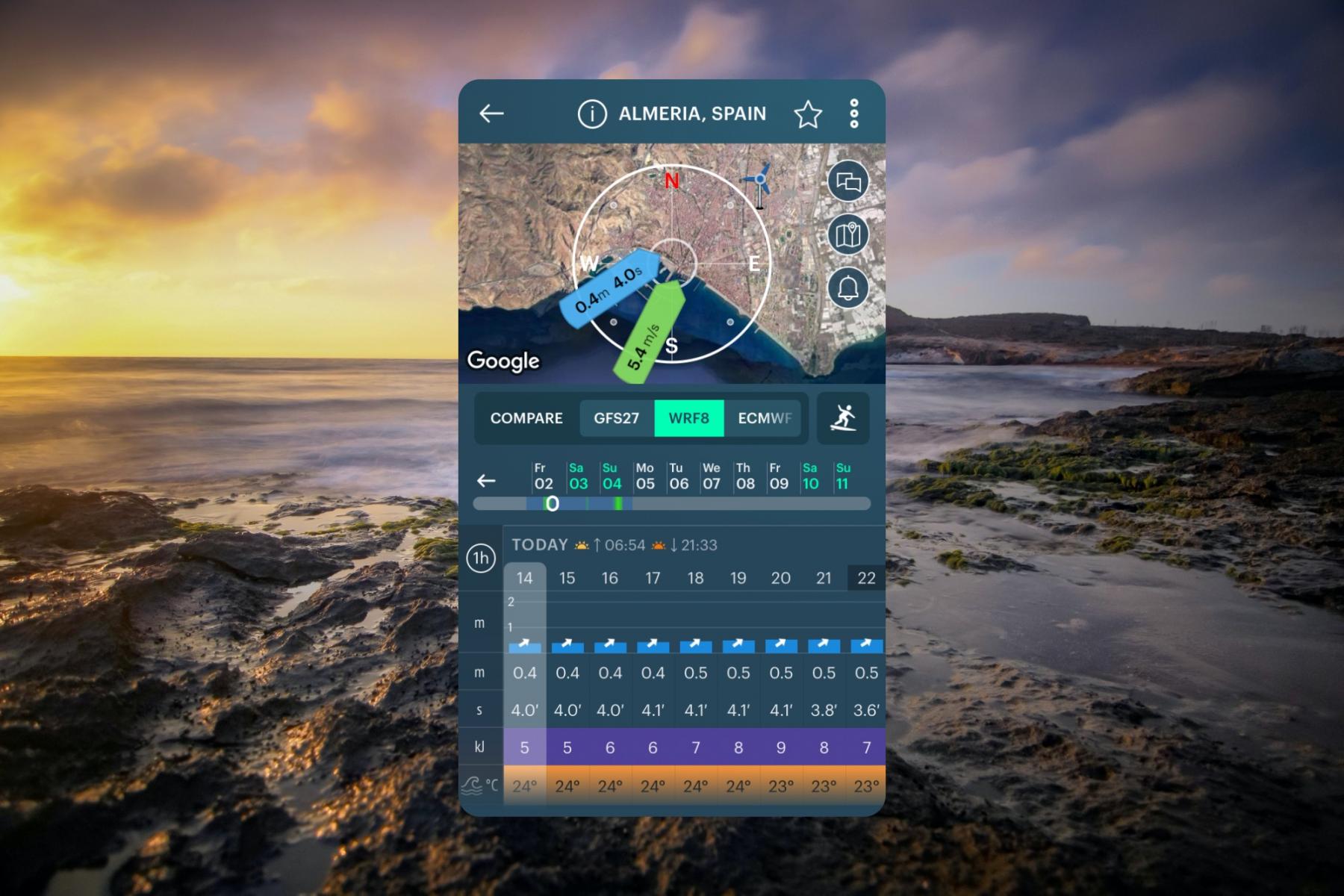
Weather forecast for Almeria for kitesurfing, windsurfing and surfing in Spain in the Windy.app for iOS
An overview
Almeria is located in the extreme southeast of the Iberian Peninsula. It is the capital of its homonymous province and belongs to the autonomous community of Andalusia in Spain. Almeria is classified as the most arid city in Europe and has more than 200 km of beaches.
This area is new to the surfing scene, less than two decades ago that began to consolidate, is a spot for surfers open to experience, if you are one of those who like to get out of the conventional destinations and take a look at new places, then it is ideal for you. Although the consistency of the waves is not the same as in other regions of Spain, you can get good sessions with volcanic bottoms and the best thing is that it is not the favorite destination for the most experienced surfers, it is an ideal scenario for beginners or amateurs rather than professionals. If you are just starting in the world of wind sports, here is a guide to everything you need to know.
Another advantage is the number of reserves and natural parks, among which we recommend above all the Cabo de Gata-Níjar Natural Park, where marine activities are combined with waves up to 2 meters perfect for surfers and land activities such as hiking. It is an area with a rocky bottom, so it is recommended for the most experienced, also the presence of sea urchins is a factor to take into account.
The main weather features
The weather in Almeria is of a warm semi-arid type, however, in the coastal area, it can be considered Mediterranean type, characterized by its almost desert-like landscape due to the pronounced aridity of the area.
The wind is one of the main characteristics of Almeria. It has about 200 mm of precipitation per year, with approximately 25 days of rainfall. It is located 43 meters above sea level.
- Winter. It is common for the strong north wind which raises big waves and you need a 4/3 wetsuit
- Spring. Ideal weather for experienced kitesurfers, especially in the town known as Roquetas de Mar.
- Summer. It is completely forbidden to practice windy water sports because the prevailing wind during this period is from the east.
- Autumn. It is an ideal time for the practice of any of the nautical sports because it presents a mixture of days with wind from the west and the east.
Best time to travel
The best time to visit Almeria will depend on your interests — for sure you won’t want to visit in the summer, given the bans on water sports. But from September onwards you will find all kinds of waves, winds, and scenery. The choice will depend on the level of experience, the purpose of the day, and the weather conditions.
Here you find our Guide of weather parameters, data, indexes, icons and graphics. After reading this post you will surely have an idea of what is the time and the beaches you are most interested in, in any case, the wind is a constant in Almeria.
Murcia
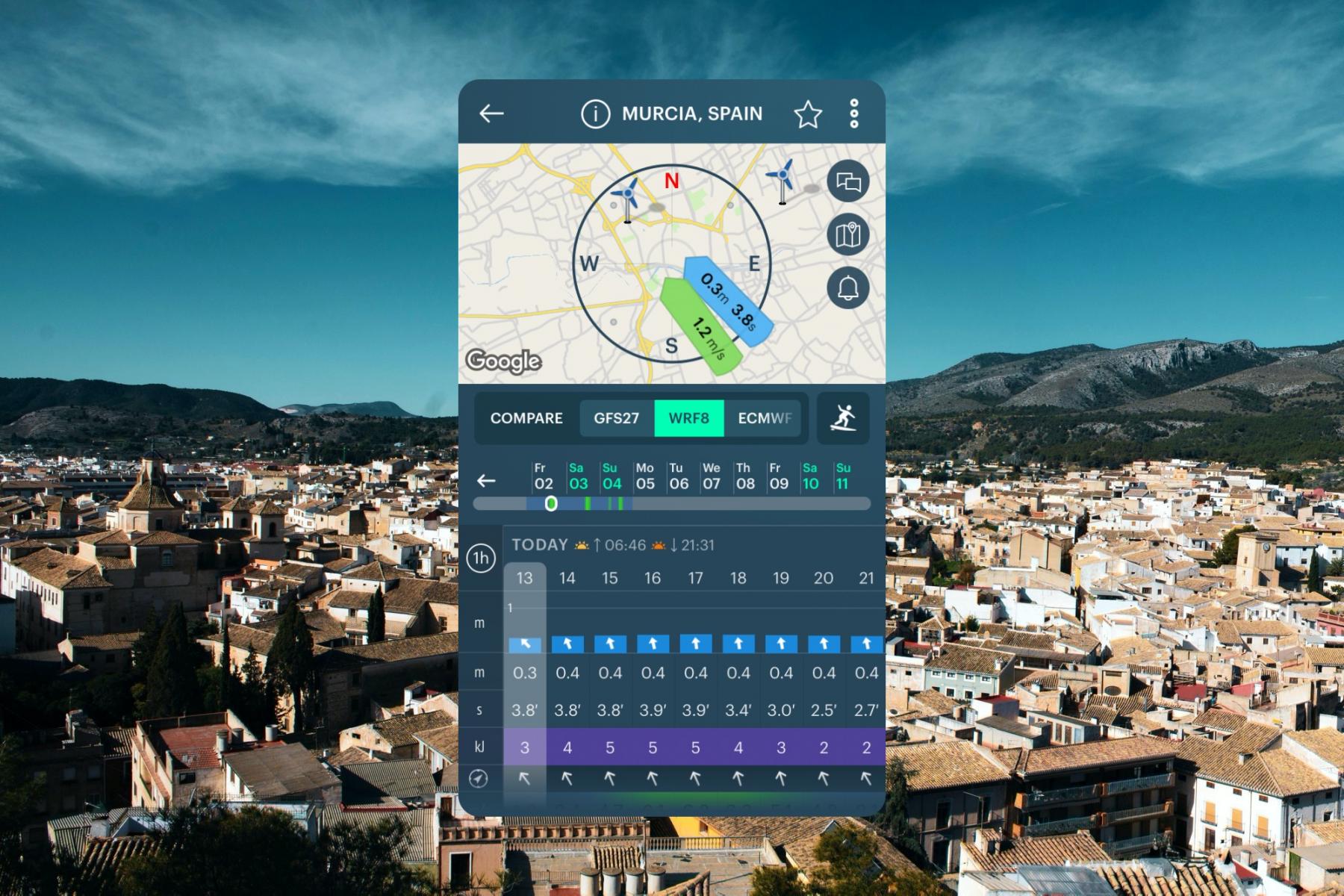
Weather forecast for Murcia for kitesurfing, windsurfing and surfing in Spain in the Windy.app for iOS
An overview
Murcia, also known as Costa Cálida, is the capital of its namesake province, is located on the southeastern coast of Spain, 40 km from the Mediterranean. It is not a traditional surfing destination, it is relatively new, it does not have waves of much consistency but winter brings some possibilities. It is creating a scenario more than anything at the training level, with schools but also taking surfing to even academic and university levels. It is known for its women’s surf league.
Murcia is a destination with possibilities for windsurfing and kitesurfing, highlighting also.
The beauty of its natural areas turns the practice of water sports into a contemplative exercise, an experience to enjoy reserves and scenarios with high levels of conservation.
Additionally, given the number of natural reserves, alternatives such as mountain biking and hiking can be an interesting complement.
The main weather features
The weather in Murcia is practically Mediterranean, as it has pronounced acidity, hot summers, and mild winters. It has only some torrential rainfall during the year, about 65 days of rain per year (312 mm). The month with the highest winds in February with 12 km/h, October is the calmest with an average speed of 7 km/h.
- Winter. Between the end of December and the end of March the most frequent winds are from the east and northeast. We recommended La Plana Beach in this time.
- Spring. There are an average of 19 days of rain. We recommended the Mar Menor is the ideal setting for kitesurfing during the spring period, with light to medium winds, shallow, calm waters, and mild temperatures.
- Summer. The biggest influx of tourists is at this time, so you need to check the restrictions on visiting beaches.
- Autumn. Good period for kitesurfing, few people on the beach, small waves.
Best time to travel
The best time to visit Murcia for surfers without a doubt is autumn-winter where they will find the most demanding waves. While between spring and summer windsurfing and kitesurfing are the protagonists.
In any case with 300 days of sunshine and an average annual temperature of 19 °C Murcia is an ideal place for water sports and is consolidated as an ideal setting for beginners with a large number of schools offering lessons throughout the year.
Palma de Mallorca
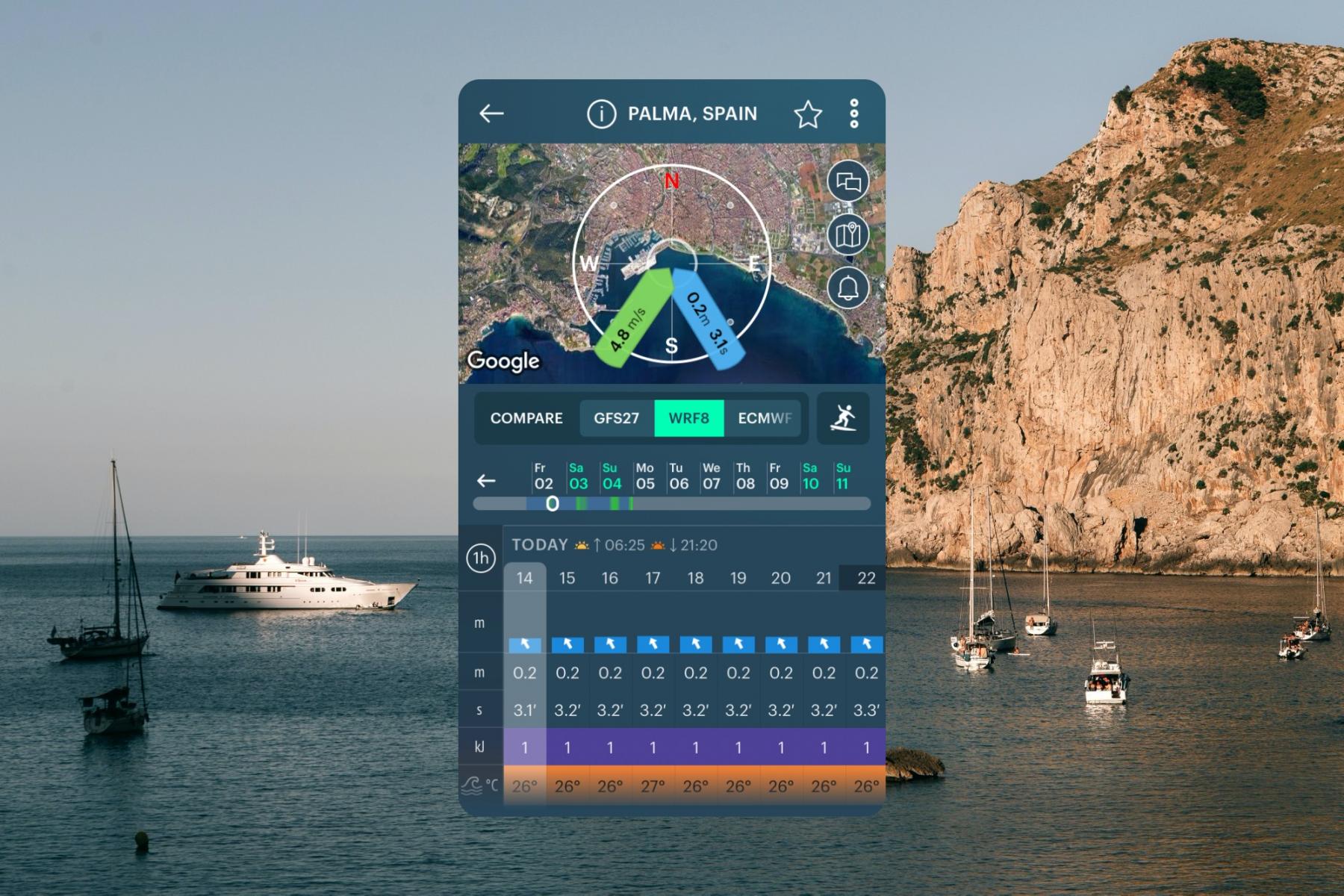
Weather forecast for Palma for kitesurfing, windsurfing and surfing in Spain in the Windy.app for iOS
An overview
Palma de Mallorca is the capital of the Balearic Islands and is located on the island of Mallorca. It is located in the southwest of Europe. It has the Bay of Palma, one of the best places for windsurfing and surfing in the south of the island.
It is known for water sports, among which stand out, in addition to windsurfing and kitesurfing, kayaking, paddle surfing, and swimming. An interesting alternative to these sports is cycling, which has gained momentum in recent years with coastal and maritime rides.
The main weather features
The weather in Palma is classified as the Mediterranean with mild winters and hot and sunny summers, with a constant breeze. Rainfall is not abundant, on average 55 days a year, and is more frequent in the cold half of the year, in contrast, the summer is dry with a low probability of rain.
- Winter. It is a period of wind and rain. The maximum temperature is around 15 °C and the minimum is 5 °C with 16 days of rain during the season.
- Spring. April is the ideal season for kitesurfers, given the local thermal wind or sea breeze that develops over land and has a variable intensity of 15 knots.
- Summer. The weather during June and July presents wind in 99% of the days. It is an ideal season for kitesurfing. High probability of thermal winds.
- Autumn. Very unreliable weather for kitesurfing lessons due to the weather conditions. Therefore not recommended for beginners.
Best time to travel
The best period to visit Palma for kitesurfers is spring without a doubt since there are no restrictions in the different areas of the island for the practice of this sport. It is also the period with the best weather conditions.
On the other hand, for windsurfers, the best season is June and July, where the thermal wind is guaranteed.
Alicante
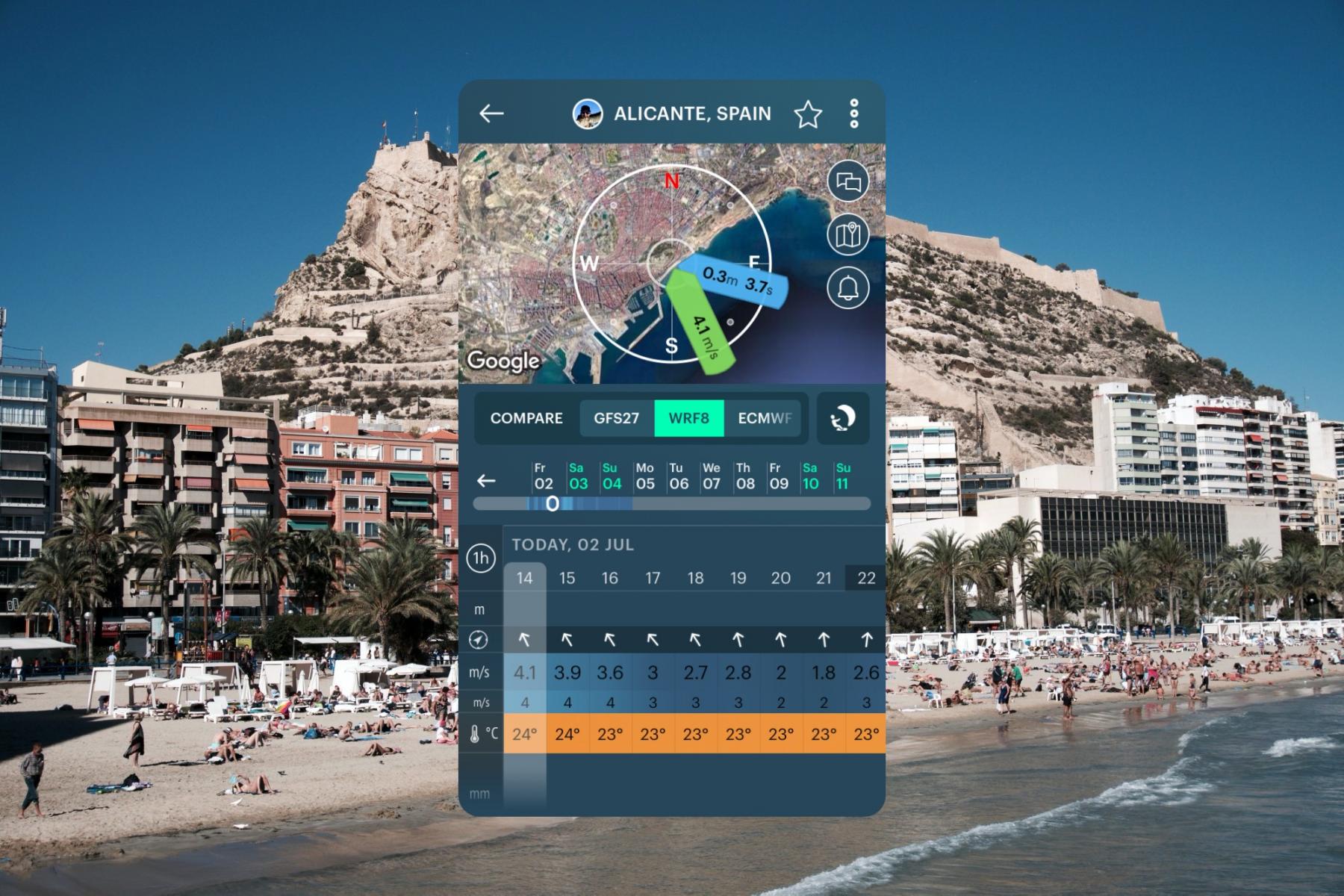
Weather forecast for Alicante for kitesurfing, windsurfing and surfing in Spain in the Windy.app for iOS
An overview
Alicante is a city in Spain, capital of the homonymous province belonging to the Valencian Community, is located on the Mediterranean coast on the southeastern coast of Spain.
It has more than 32 km of coastline, which makes it an interesting setting for water sports. But it should be clarified that it is not a destination with a surfing tradition because it does not have waves as consistent as in other areas of Spain. It has a great advantage since it is not a surfing spot by nature and there are beaches with a small number of surfers, it requires only a little more search and consultation of the best places and the best seasons.
The main weather features
The weather in Alicante is the Mediterranean, characterized by mild and relatively rainy winters and sunny and hot summers. It has a low level of rainfall per year, about 37 days of rain per year (285 mm). Humidity ranges from 60% to 68% per year and the water temperature is always above 14 °C (57 °F).
- Winter. It is mostly warm, but sometimes there are rainy days with a strong wind for small sizes
- Spring. Very good thermal winds, but sometimes in late spring there are afternoon thunderstorms
- Summer. Given the predominance of Levante winds, it is an ideal period for kitesurfing
- Autumn. Westerly winds predominate but there are also temperate winds during this season thanks to what small waves arise
Best time to travel
The best period to visit Alicante depends on the goals you have, if your thing is surfing then choose the season between autumn and winter but do not forget that spring also allows the practice, especially if you are just starting.
If you are into kitesurfing or windsurfing then you will want to visit during the summer season. However, it is a destination where you can find good waves and good weather throughout the year, just be informed of weather forecasts.
Learn more about how to read the surf / swell forecast in a special Windy.app presentation with examples and tips from professional surfers with many years of experience of riding the biggest and best waves on the planet.
Text: Diana Marcela Zuluaga. Ivan Kuznetsov and Masha Shapovalova contributed to this guide
Cover photo: Emma Li / Pexels
You will also find useful
What are the different types of windsurf sails
Latest News
Professional Weather App
Get a detailed online 10 day weather forecast, live worldwide wind map and local weather reports from the most accurate weather models.
Compare spot conditions, ask locals in the app chat, discover meteo lessons, and share your experience in our Windy.app Community.
Be sure with Windy.app.



